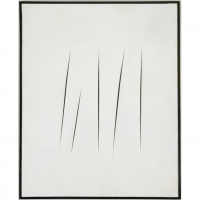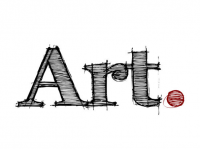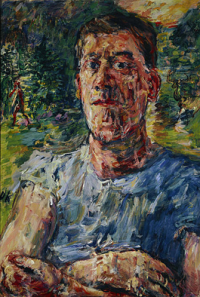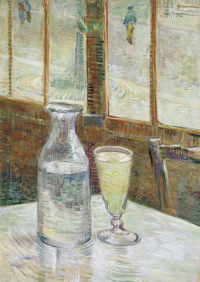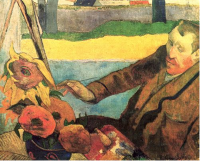Sorry, this entry is only available in French.
As much as elders tell young children to dismiss name-calling or bad words, words possess a stronger meaning than most people care to admit. A photograph may be worth 1,000 words, but can a word not also invite 1,000 ideas or influence 1,000 images?
Art is subjective to the viewer’s personal history, and language is supposed to be agreed upon by the general audience, with dictionaries giving precise definitions to every word. But neither Merriam nor Webster can anticipate the insurgence of connotative meaning that can ultimately redefine a word in a specific culture.
The importance of language and its relationship to art is currently being examined at the Tate Liverpool, in an exhibition centered on Raymond Williams’s Keywords: A Vocabulary of Culture and Society, an exploration of the evolutionary nature of language in face of an ever-changing society. Strong words such as ‘sex’, ‘materialism’, or ‘liberation’ are all juxtaposed by a work of art intended to reflect those keywords.

Bill Woodrow, Car Door, ironing Board and Twin-Tub with North American Indian Head-Dress, 1981.
Mixed media, 186.5 x 283 x 157 cm.
Tate Collection, London.
Can you guess what the Keyword associated with these objects is? Identity? Integration? Modernization?)
Words will never physically assault a person (unless you hurl a dictionary at someone), but language is still a powerful force, too subjective and too transient to be defined.
-D.R.
To see more of the collaboration between art and language, visit the Tate Liverpool’s ongoing exhibition Keywords: Art, Culture and Society in 1980s Britain, running until 11 May 2014. While many distinguish art and words, some artists, like those featured at the Tate, marry the two to create new images. For an in-depth example of an artist who adeptly featured words in his art, you can peruse a copy of Parkstone International’s Mucha, which illustrates some of Mucha’s typography works.
Sorry, this entry is only available in German.
It is not the mission of art to wallow in filth for filth’s sake, to paint the human being only in a state of putrefaction, to draw cretins as symbols of motherhood, or to present deformed idiots as representatives of manly strength.
So declared Adolf Hitler in 1935, leaving no uncertainty over his views on much of modern art. Many German and Austrian artists at the time were trying to express their own views of the world and their anger and despair towards society following the horrors of the First World War, yet Hitler saw only intolerable statements undermining his vision of a perfect German society.

Ernst Ludwig Kirchner, A Group of Artists: Mueller, Kirchner, Heckel, Schmidt-Rottluff, c. 1926-1927.
Oil on canvas, 168 x 126 cm.
Museum Ludwig, Cologne.
In 1937, the Degenerate Art show opened in Munich. The National Socialist regime had seized hundreds of artworks which they considered ‘filthy’ and put them all on display, aiming to exhibit for the public exactly the kind of art that they should be wary of. Whether they agreed with Hitler’s condemnations of modern art or not, the public visited in their hordes. Many of the artists displayed here, and all over Austria and Germany as the show travelled over the next three years, are today some of the nations’ best known and most well loved. They include Max Beckmann, Ernst Ludwig Kirchner, Emil Nolde, Paul Klee, and Oskar Kokoschka.

Oskar Kokoschka, Self-Portrait as a Degenerate Artist, 1937.
Oil on canvas, 110 x 85 cm.
Scottish National Gallery of Modern Art, Edinburgh.
The idea of art censorship is one that seems very black and white for us today. Of course, this particular example is an extreme one, but what do you think? Do you think there is ever reason for a government to ban certain art, or do you think people should be able to display whatever they want? The kind of art that Hitler preferred certainly gives us an idea of the mundane style that results from stomping down on creativity… this is a painting by Hitler’s favourite painter:

Adolf Ziegler, The Four Elements: Fire, Earth and Water, Air, 1937.
Oil on canvas.
Pinakothek der Moderne, Munich.
Though the Neue Galerie in New York is dedicated solely to German and Austrian art, this is the first time that it has created an exhibition dealing specifically with the Nazi period. Hurry along to see Degenerate Art: The Attack on Modern Art in Nazi Germany, 1937 until 30 June 2014. If you’d like to read more about some of the artists in the exhibition, check out Ashley Bassie’s Expressionism or Klaus Carl’s Kirchner.
G.A.
Sorry, this entry is only available in German.
In an attempt to manipulate the power of the Internet, the Museum of Fine Arts in Boston used crowdsourcing to select pieces for its ongoing exhibition, Boston Loves Impressionism. During the month of January, the MFA held an online vote every week, garnering up to 41,000 votes.
This exhibition explores the predominating artistic taste of Bostonians. It neither focuses on the Impressionist movement nor on the individual artists, but rather highlights the connection Boston feels towards each piece.
The top three selected works are undeniable favorites. Van Gogh’s Houses at Auvers received the most votes, surpassing Claude Monet’s Water Lilies by at least 1,000 total votes. The only sculpture in the contest, Edgar Degas’s Little Fourteen-Year-Old Dancer, managed to come in third.
While Van Gogh outdid the rest in terms of votes, Monet outdid him in quantity, as he painted thirteen of the thirty featured works. Van Gogh, on the other hand, is only represented by two works, Houses at Auvers and Ravine.

Edgar Degas, Ballet Dancer with Arms Crossed, c. 1872.
Oil on canvas, 61.3 x 50.5 cm.
Museum of Fine Arts, Boston.
Among the likes of Renoir, Monet, Cézanne, and Van Gogh is Mary Cassatt, the only American and the only woman featured in the exhibition. Even during her time, Cassatt proved her ability against the other Impressionists, and was even invited to exhibit with the group, becoming one of three women and the only American to do so.
Clearly, Boston has an infatuation with French Impressionist painters, but it also has a deep respect for Mary Cassatt, a true artist regardless of gender or nationality.
Visit the Museum of Fine Arts Boston to see its ongoing exhibition Boston Loves Impressionism and explore the implementation of crowdsourcing in curating. If you feel like enjoying the works of the champion Monet, you can purchase a copy of Parkstone International’s latest release Art Gallery, a collection of ten books featuring Impressionist Van Gogh, Renoir, and Monet.
-D.R.
Even the most ardent art lovers will admit that the subject can be a little… overwhelming. Take a stroll through the halls of the Louvre and though it is incredible, sometimes it is a little TOO incredible – after a while you just need to sit down. It’s estimated that to see everything that is on display in the Louvre you would need to be there for about three weeks. Solidly. Seeing masterpiece after masterpiece can get a little confusing, and after a while they might start to blur together… Just be thankful that galleries don’t tend to look like this anymore:

Giovanni Paolo Pannini, Picture Gallery with Views of Modern Rome, 1757. Oil on canvas, 170.2 x 244.5 cm. Museum of Fine Arts, Boston.
Even so, sometimes it’s good to simplify things a little and learn about one artist at a time. It can be very refreshing to visit the Van Gogh Museum in Amsterdam, for example, and feel like you can really immerse yourself in the art of just one of the numerous great masters history has produced. It’s also a good way to learn a little more about art, and pick up some interesting facts to throw across the table at a dinner party – “Did you know that Leonardo da Vinci was the illegitimate son of a peasant girl?”

Leonardo da Vinci, Self-Portrait, c. 1512. Red chalk on paper, 33.3 x 21.3 cm. Biblioteca Reale, Turin.
If you’d like to learn a little more about some of the greatest artists in history, from Leonardo da Vinci and Raphael to Claude Monet and Vincent van Gogh, then Parkstone International has just the thing for you. Our new Art Gallery collection contains ten pocket-sized books, each dedicated to a different artist and offering information on their life and art, as well as a beautiful selection of their best works. Flick through at your leisure and pick up some interesting tit-bits to throw out next time you want to impress…

Eine quadratische Fläche, komplett in Schwarz präsentierte der russische Avantgarde-Künstler Kasimir Malewitsch erstmals 1915 der Öffentlichkeit. Was für eine Sensation! Gleichzeitig löste das Bild aber auch Unverständnis und Ablehung aus – konnte der Betrachter weder Gegenständliches noch Formen oder Linien in diesem Werk erkennen. Malewitsch hatte ein Gemälde erschaffen, dass sich von allem bisher Dagewesenen gelöst hatte und inmitten der Ereignisse des Ersten Weltkrieges eine dunkle Vorahnung auf die Zukunft implizieren sollte.

Kasimir Malewitsch: Das Schwarze Quadrat auf weißem Grund, 1915. Öl auf Leinwand, 79 x 79 cm. Tretjakow Galerie, Moskau.
Heute ist das Schwarze Quadrat auf weißem Grund von Malewitsch eine Ikone der modernen Malerei und in zahlreichen Kunstgeschichtsbüchern des 20. Jahrhunderts vertreten. Der Künstler selbst gedenkt Zeit seines Lebens wiederholt an sein Meisterwerk, wie in seinem Selbstporträt von 1933. In diesem erinnert seine im Bildmittelpunkt befindliche Handhaltung an die Form eines Quadrates und er signierte das Gemälde am unteren rechten Rand mit einem schwarzen Quadrat.

Kasimir Malewitsch: Selbstporträt, 1933. Öl auf Leinwand, 73 x 66 cm. Russisches Museum, Sankt Petersburg.
Mit seinen Werken begründete der außergewöhnliche Künstler und Kunsttheoretiker eine vollkommen neue, eigene Stilrichtung, den „Suprematismus“, eine abstrakte Kunstentwicklung, die sich grundlegend von den traditionellen Kunstauffassungen befreit hatte.
Das Kunstmuseum Basel zeigt vom 1. März bis zum 22. Juni 2014 eine Retrospektive des russischen Künstlers mit dem Titel „Kazimir Malevich – Die Welt als Ungegenständlichkeit“. Im Verlag Parkstone International ist das Buch Malewitsch von Gerry Souter erschienen, welches sich dem brillanten Künstler und Begründer des „Suprematismus” widmet.
Ear-chopping episode aside, sunflowers are probably one of the most iconic images associated with Vincent van Gogh. Beloved for their sunny, cheerful appearance and bold shapes, it has been estimated that around 5 million people see the artist’s paintings of these flowers every year.

Sunflowers, Paris, August-September 1887. Oil on canvas, 43.2 x 61 cm. The Metropolitan Museum of Art, New York.
Van Gogh had previously painted pictures of dying sunflower heads during his time in Paris, in 1886-1888. Increasingly concerned with symbolism, he returned to colourful flowers when preparing for his fellow artist, Paul Gauguin, to come and stay with him in Arles. Excited for his friend’s visit, Van Gogh wanted to offer him a warm welcome and seized upon paintings of sunflowers as the ideal decorative scheme. Thus emerged a series of paintings of the flowers, arranged in earthenware vases and painted rapidly, as they steadily wilted.
In August 1888, Van Gogh wrote to his brother, Theo, “I am hard at it, painting with the enthusiasm of a Marseillais eating bouillabaisse, which won’t surprise you when you know that what I’m at is the painting of some sunflowers.” These sun-aping flowers have traditionally been associated with happiness, and are a symbol of loyalty in Dutch literature. Little surprise, then, that as a lover of colour and its emotional force, Van Gogh would choose these yellow beacons to welcome Gauguin to his house. Just four months later, their time together would end in terrible arguments and the aforementioned ear-removal. For that summer, however, Van Gogh was optimistic and leaves these bold paintings to us as a reminder of his fleeting hopefulness.

Sunflowers, 1889. Oil on Canvas, 95 x 73 cm.
Van Gogh Museum, Amsterdam.
Source: http://www.vangoghmuseum.nl/vgm/index.jsp?lang=nl
The National Gallery in London is currently playing host to the Sunflowers owned by the Van Gogh Museum, in Amsterdam, which they are displaying alongside their own version. Head along to the National Gallery before the 27 April, 2014 for a look at these much-loved works for yourself. If you’d like to read more about Vincent van Gogh, grab a copy of Victoria Charles’ in-depth look at the great master, or Van Gogh in his own words, in our book from the Mega Square collection.
G.A.
Sorry, this entry is only available in German.
By Category
Recent News
- 04/03/2018 - Alles, was du dir vorstellen kannst, ist real
- 04/03/2018 - Tout ce qui peut être imaginé est réel
- 04/03/2018 - Everything you can imagine is real
- 04/02/2018 - Als deutsche Soldaten in mein Atelier kamen und mir meine Bilder von Guernica ansahen, fragten sie: ‘Hast du das gemacht?’. Und ich würde sagen: ‘Nein, hast du’.
- 04/02/2018 - Quand les soldats allemands venaient dans mon studio et regardaient mes photos de Guernica, ils me demandaient: ‘As-tu fait ça?’. Et je dirais: “Non, vous l’avez fait.”
